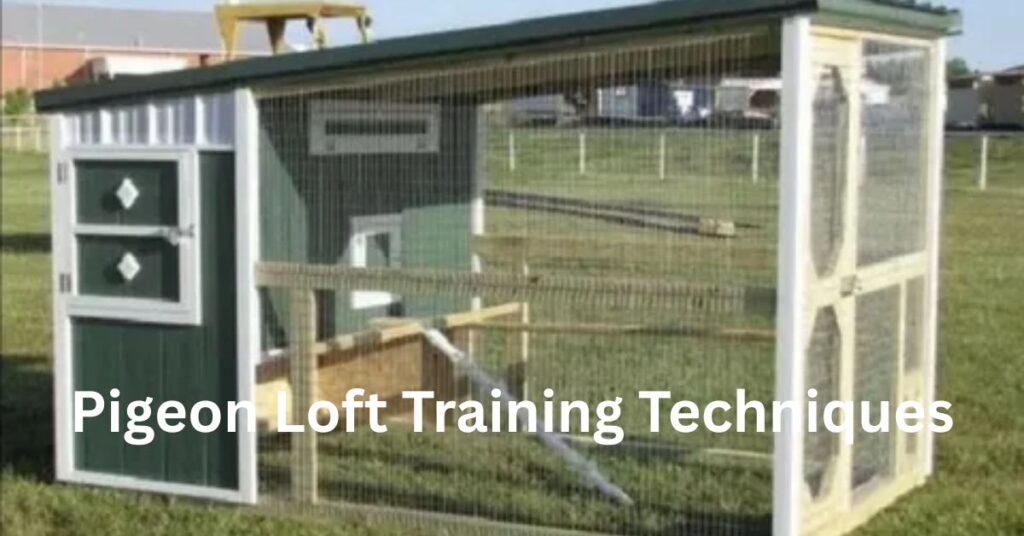When it comes to raising and racing pigeons, one of the most essential skills every beginner should master is pigeon loft training. Proper training ensures your birds not only recognize their home but also return safely and swiftly after every flight. In this guide, we’ll walk you through everything you need to know, from setup to flight, using clear, beginner-friendly language and, yes, a few helpful anecdotes along the way.
Pigeon Loft Training Techniques for Beginners
Before you begin, it’s crucial to understand that pigeons are creatures of habit. Their natural homing instincts can be sharpened with structured routines and positive associations. To get started with pigeon loft training techniques for beginners, here are the foundational steps:
1. Choosing the Right Location for Your Loft
Your pigeon loft is the central training hub. Place it in a safe, open, and elevated area away from predators like cats or hawks. The goal is to make the loft easy for pigeons to identify during flight. A well-lit, dry, and secure environment goes a long way.
2. Initial Acclimatization to the Loft
Confine new pigeons to the loft for 4–6 weeks. This builds familiarity. Feed them consistently and keep their environment clean. Afterward, start by letting them perch outside the loft in a cage for a few hours each day.
🕊️ A tip from seasoned breeders: Don’t rush this phase. The stronger the bond to the loft, the more reliable your flyers will be.
High Flyer Pigeon Training: Teaching Altitude and Endurance
High flyer pigeons are admired for their long-distance and high-altitude capabilities. But reaching this level requires specific training:
- Begin with short flights: 10–15 minutes daily.
- Gradually increase flight duration.
- Watch their flight patterns to ensure they form a flock.
📌 Pro tip: Avoid training during extreme heat (above 40°C) to prevent overheating.
🔗 Learn more about training high-flying pigeons
Training Young Flyer Pigeons: Step-by-Step
Young pigeons, or squeakers, need gentle handling and a structured routine. Here’s how to start training young flying pigeons:
Step 1: Cage Time
- Confine them to the loft.
- Feed them at the same time each day.
Step 2: Controlled Outdoor Exposure
- Use a mesh cage outside the loft.
- Let them observe their surroundings for 2–4 hours daily.
Step 3: Group Flying
- After 10–15 days, allow young birds to fly with older pigeons.
- Always feed before and after flights to reinforce the loft as ‘home’.
High Flyer Pigeons for Beginners: Choosing the Right Breed
Not all pigeons are born equal when it comes to performance. Some breeds are naturally inclined toward high flying. For high flyer pigeons for beginners, consider:
- Tipplers: Known for their incredible endurance.
- Rollers: A great choice for aerial acrobatics.
- Homing pigeons: Ideal for distance and return precision.
🎯 Anecdote: One breeder from Illinois recalled how his first high flyer, a Roller named Blue, flew so high that it disappeared for 6 hours and returned just in time for dinner.
Loft Flying Racing Pigeons: Building the Routine
Before road training or races begin, your birds’ master loft must fly. Here’s how to build consistency:
- Fly daily: Early mornings or late afternoons.
- Duration: Start with 20–30 minutes, increasing to 1–2 hours.
- Rest Days: Provide rest every 4–5 days to prevent fatigue.
🔗 Tips on training racing pigeons at home
Pigeon Racing for Beginners: From Loft to Road Training
Once your pigeons are comfortable with loft flying, it’s time for basket and road training — the transition toward pigeon racing for beginners.
1. Training Crate Familiarization
- Place pigeons in a training crate for 1–2 hours at a time.
- Let them adapt to close quarters and other birds.
2. Short Distance Tosses
- Start at 1 mile from the loft.
- Use clear, obstacle-free areas like empty parking lots.
3. The Confidence Method
- Only increase the distance after 3 successful returns.
- Follow a distance schedule: 1 mi → 3 mi → 5 mi → 10 mi → 20+ mi
🔗 Full guide on road training pigeons
📌 Bonus Tip: Never feed before tosses. Hunger is their best motivator to return.
Troubleshooting Common Loft Training Issues
Even with a solid plan, things can go sideways. Here are common problems and solutions:
- Pigeons not returning? Recheck feeding times and training distances.
- Injury or exhaustion? Give 1–2 rest days and observe health.
- Overheating? Avoid training in direct midday sun.
Final Thoughts: Training That Pays Off
Pigeon loft training techniques: a comprehensive guide for beginners isn’t just a title, it’s a roadmap to a lifelong hobby. With dedication, structure, and the right methods, you’ll raise birds that fly with confidence and loyalty.
Whether you’re prepping for pigeon racing, enjoying the beauty of high flyers, or simply bonding with your birds, proper training is the backbone of it all.
🎯 So go ahead, build that loft, train with patience, and let the sky be your pigeon’s playground.
FAQ
1. How do you train pigeons to fly around the loft?
You train pigeons to fly around the loft by gradually releasing them after a confinement period and encouraging short daily flights at consistent times.
2. How to train your racing pigeon?
Start by loft training, then use crate and road training with increasing distances while tracking performance and ensuring consistent care.
3. How to make pigeons fly more?
Increase their flight time gradually through routine loft flying and ensure they are healthy, well-fed, and not flying in extreme weather.
4. What is the secret of racing pigeons?
The secret is consistent training, strong loft orientation, optimal health, and building confidence with gradual distance increases.

